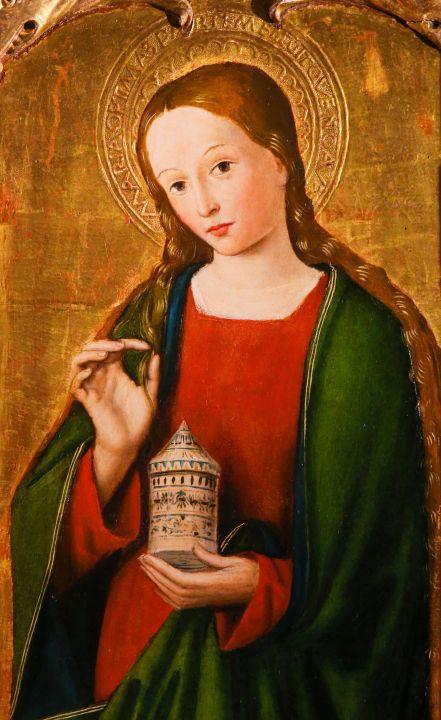Mary Magdalene was a woman who traveled with Jesus as one of His followers and was a witness to His crucifixion and Resurrection. She is mentioned twelve times in the gospels. She came from Magdala, a fishing town on the western shore of the Sea of Galilee.
The gospel of Luke lists Mary Magdalene as one of the women who traveled with Jesus and helped support His ministry “out of their resources,” indicating that she was probably wealthy. The same passage states that seven demons had been driven out of her, as also stated in Mark’s gospel. She was at his execution and also present at His burial. All four gospels identify her as either alone or as a member of a larger group which includes Jesus’ mother as the first to witness Jesus’ Resurrection.
The portrayal of Mary Magdalene as a prostitute began in 591 when Pope Gregory I combined her with Mary of Bethany and the unnamed “sinful woman” who anointed Jesus’ feet in chapter 7 of Luke’s gospel. Pope Gregory’s Easter sermon resulted in a widespread belief that Mary Magdalene was a repentant promiscuous woman. In 1969 Pope Paul VI removed the identification of her with Mary of Bethany and the “sinful woman” but the view of her as a former prostitute has persisted in popular culture.
The places where Mary Magdalene and the other women are mentioned throughout the gospels indicate that they were critical to the ministry of Jesus. The fact that she is usually listed first as a member of the group of women indicates that she was seen as most important of them, after the Blessed Mother.
According to the gospels of Luke and Mark Jesus exorcised seven demons from Mary Magdalene. In the first century demons were believed to cause physical and psychological illnesses. Scholars have suggested that the reference to the number of demons being seven may mean that she had to undergo seven exorcisms, perhaps over a long period of time due to the first being partially unsuccessful.
All four gospels agree that several other women watched the crucifixion from a distance with three explicitly naming Mary Magdalene as being present. Scholars state that the presence of these women is historical because Christians would have been unlikely to fabricate that the main witnesses to the execution of Jesus were women.
Early at the first day of the week Mary Magdalene went to Jesus’ tomb and saw that the stone had been removed from the entrance. She saw one or two angels in white (depending on whose account). When she saw Jesus he told her not to cling to Him because he had not yet ascended to the Father. It was Mary Magdalene who brought word of the risen Christ to Peter and the remaining Apostles.
Mary Magdalene is considered a saint by the Catholic, Eastern Orthodox, Anglican, and Lutheran denominations. In, 2016 Pope Francis raised the level of her liturgical memory from memorial to feast day.
 |
|
Painting of Mary Magdalene
on the Altarpiece of St Nicolas
|
